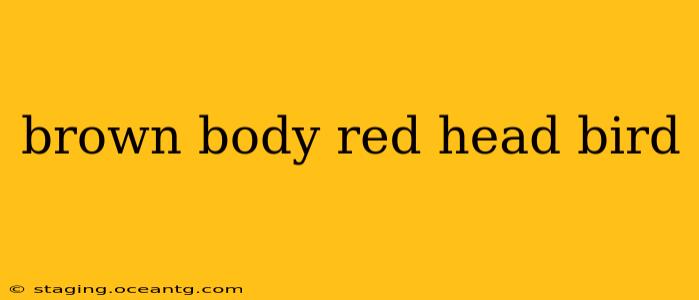Spotting a bird with a brown body and a red head can spark curiosity. Many species boast this striking color combination, making identification a fun challenge for bird enthusiasts of all levels. This comprehensive guide will help you narrow down the possibilities, exploring various bird species that fit this description and providing helpful tips for accurate identification. We'll even delve into some frequently asked questions to make your birding adventures even more rewarding.
What Kind of Bird Has a Brown Body and a Red Head?
This question leads us down a path of fascinating avian diversity. The answer isn't a single species but rather a range of birds, depending on geographic location and specific shades of brown and red. Some common possibilities include:
-
Northern Cardinal (Male): Arguably the most recognizable bird fitting this description, the male Northern Cardinal is famous for its vibrant crimson head and crest, contrasted against a rich brown back and wings. They are common in North America.
-
Red-headed Woodpecker: This striking woodpecker boasts a bold, entirely red head, contrasting sharply with its pure black and white wings and back. The body itself, while mostly black and white, might appear brownish from a distance, particularly in shadowed areas.
-
Red-bellied Woodpecker: While the name suggests a red belly, the male Red-bellied Woodpecker often displays a red cap and nape (back of the neck) which, from certain angles, can appear as a red head, especially when viewed at a distance or in less-than-ideal lighting. Their backs are primarily brown or grayish-brown.
-
Red-breasted Nuthatch: Although the red is primarily on the breast, the spread of red can sometimes give the impression of a reddish head, particularly in certain poses. Their backs and wings are a mottled brown.
What Bird Has a Brown Body and a Reddish-Brown Head?
The distinction between "red" and "reddish-brown" is crucial for accurate identification. Several species might fall into this category:
-
Brown-headed Nuthatch: This nuthatch features a more muted reddish-brown cap, which contrasts with its grayish-brown back. The coloration is less vibrant than the Red-breasted Nuthatch.
-
Several Sparrow Species: Many sparrow species exhibit varying shades of brown and reddish-brown on their heads and bodies. Accurate identification within this group often requires attention to finer details like streaking patterns, beak shape, and size. Specific examples may need regional considerations for identification.
-
Juvenile Birds: Young birds of various species might show less intense coloration than their adult counterparts. A juvenile bird might exhibit a duller reddish-brown on its head as it develops its adult plumage.
How Can I Identify a Brown Body, Red Head Bird?
Successful identification goes beyond just color. Consider these additional factors:
-
Size and Shape: Note the overall size of the bird compared to other familiar birds in your area. Pay attention to the shape of its beak, wings, and tail.
-
Habitat: Where did you see the bird? Different birds prefer different habitats. A woodpecker would likely be found near trees, while a cardinal might be in a shrub or garden.
-
Behavior: How did the bird behave? Was it hopping on the ground, clinging to a tree trunk, or flying in a specific pattern?
-
Location: Your geographic location dramatically impacts the species you are likely to encounter.
What is the Best Way to Identify Birds?
Using a combination of field guides, bird identification apps (like Merlin Bird ID or iNaturalist), and online resources can significantly improve your identification accuracy. High-quality photographs or even short videos can aid in identifying subtle features that might be missed with a quick observation. Joining local birding groups or attending bird walks can also boost your skills and knowledge through interactions with experienced birders.
What are Some Common Mistakes Made When Identifying Birds?
A common mistake is relying solely on color. Lighting conditions, distance, and the bird's posture can all affect how its colors appear. Paying close attention to shape, size, behavior, and habitat is crucial to avoid misidentification. Another pitfall is assuming a bird's age based solely on color. Juveniles often have duller plumage than adults.
By carefully observing these details and using available resources, you'll confidently identify that captivating brown-bodied, red-headed bird and enrich your appreciation for the avian world. Remember that patience and practice are key to becoming a skilled bird identifier!
